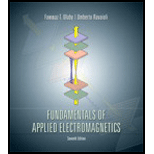
Concept explainers
A 2 kHz sound wave traveling in the x direction in air was observed to have a differential pressure p(x, t) = 10 N/m2 at x = 0 and t = 50 μs. If the reference phase of p(x, t) is 36°, find a complete expression for p(x, t). The velocity of sound in air is 330 m/s.
The complete expression for differential pressure
Answer to Problem 1P
The complete expression for
Explanation of Solution
Given data:
The differential pressure
The reference phase of
The velocity of the sound in air is
The frequency of the sound wave is
Calculation:
The formula to calculate the angular frequency is given as,
Here,
f is frequency of the sound wave and
Substitute
The formula for the wavelength of the sound wave is given as,
Here,
Substitute
The formula for the phase constant is given as,
Here, the phase constant is
Substitute
The expression for the differential pressure is given as follows.
Here,
Substitute
Further solving the above expression as,
Substitute
Conclusion:
Therefore, the complete expression for
Want to see more full solutions like this?
Chapter 1 Solutions
Fundamentals of Applied Electromagnetics (7th Edition)
- A domestic load of 2300 kW at 0.88 p.f lagging and a motors load of 3400 kW at 0.85 p.f lagging are supplied by two alternators operating in parallel. If one alternator is delivering a load of 3300 kW at 0.9 p.f lagging, what will be the output power and p.f of the other alternator?arrow_forwardDesign a bank of capacitors to provide 60V and 2kWh energy to capture and store regen breaking energy. Use commercial supercapacitor cells at 3V and 3600F. Capacitor voltage drops almost linearly during discharge and below half voltage maximum it doesn’t provide significant power. If we discharge a fully charged capacitor to its half voltage maximum, how much energy can be discharged compared to a full-discharged capacitor (show your calculation)?arrow_forward8-1) similar to Lathi & Ding, Prob. P.5.1-2 The figure below shows the Fourier spectra of signals of g,(t) and g₁(t). Determine the Nyquist rate and the corresponding sampling interval for signals of g,(t), g,(t), g₁(1) - g¸(1), g¸³(t), and g₁(1)g₁(1). Hint: Use the frequency convolution and the width property of convolution. G₁(f) G₂(f) -8000 0 8000 f -20000 10 20000 farrow_forward
- Calculate the approximate values of the starting current, full-load current, and no- load current of a 150 horsepower, 575 V, 3- phase induction motor.arrow_forwardCapacitor voltage drops almost linearly during discharge and below half voltage maximum it doesn’t provide significant power. If we discharge a fully charged capacitor to its half voltage maximum, how much energy can be discharged compared to a full-discharged capacitor (show your calculation)?arrow_forwardDesign a bank of capacitors to provide 60V and 2kWh energy to capture and store regen breaking energy. Use commercial supercapacitor cells at 3V and 3600F.arrow_forward
- Please explain in step by step detail how to answer and solve this problemarrow_forwardTwo loads connected in parallel are respectively 2 kW at a pf of 0.75 leading and 4 kW at a pf of 0.95 lagging. Calculate the pf of the combined two loads. Find the complex power supplied by the source. Hints: • • Since the two loads are parallel, the complex power, S, supplied by the source is S = S₁+ S₂ Calculate the complex powers, S₁ and S2, of each load (use power triangles) and add them to find the total S. Calculate 0 and obtain pf.arrow_forwardA 3-phase, 20-pole induction motor is con- nected to a 600 V, 60 Hz source. a. What is the synchronous speed? b. If the voltage is reduced to 300 V, will the synchronous speed change? c. How many groups are there, per phase?arrow_forward
- Starting from Maxwell’s equations derive the Kirchohf’s circuit laws for voltage and current. Clearly mention what approximation is used for this derivation.arrow_forwardIn the control system shown in Figure Q4(a), G₁(s) = and G₂(s) == If the system has the specifications for the natural frequency and dampingratio of -5 rad/sec and {=0.7, respectively, determine K and H,(s) when H₂(s) = 1.arrow_forwardCan the expert help me draw a curve on my graph paper? TERMINAL VOLTS 9000 8000 7000 6000 5000 4100 4000 14 18 22 26 30 34 38 FIELD AMPERES, If OPEN CIRCUIT CHARACTERSTICS Fig 3 42 42 46 50 54arrow_forward
 Introductory Circuit Analysis (13th Edition)Electrical EngineeringISBN:9780133923605Author:Robert L. BoylestadPublisher:PEARSON
Introductory Circuit Analysis (13th Edition)Electrical EngineeringISBN:9780133923605Author:Robert L. BoylestadPublisher:PEARSON Delmar's Standard Textbook Of ElectricityElectrical EngineeringISBN:9781337900348Author:Stephen L. HermanPublisher:Cengage Learning
Delmar's Standard Textbook Of ElectricityElectrical EngineeringISBN:9781337900348Author:Stephen L. HermanPublisher:Cengage Learning Programmable Logic ControllersElectrical EngineeringISBN:9780073373843Author:Frank D. PetruzellaPublisher:McGraw-Hill Education
Programmable Logic ControllersElectrical EngineeringISBN:9780073373843Author:Frank D. PetruzellaPublisher:McGraw-Hill Education Fundamentals of Electric CircuitsElectrical EngineeringISBN:9780078028229Author:Charles K Alexander, Matthew SadikuPublisher:McGraw-Hill Education
Fundamentals of Electric CircuitsElectrical EngineeringISBN:9780078028229Author:Charles K Alexander, Matthew SadikuPublisher:McGraw-Hill Education Electric Circuits. (11th Edition)Electrical EngineeringISBN:9780134746968Author:James W. Nilsson, Susan RiedelPublisher:PEARSON
Electric Circuits. (11th Edition)Electrical EngineeringISBN:9780134746968Author:James W. Nilsson, Susan RiedelPublisher:PEARSON Engineering ElectromagneticsElectrical EngineeringISBN:9780078028151Author:Hayt, William H. (william Hart), Jr, BUCK, John A.Publisher:Mcgraw-hill Education,
Engineering ElectromagneticsElectrical EngineeringISBN:9780078028151Author:Hayt, William H. (william Hart), Jr, BUCK, John A.Publisher:Mcgraw-hill Education,





